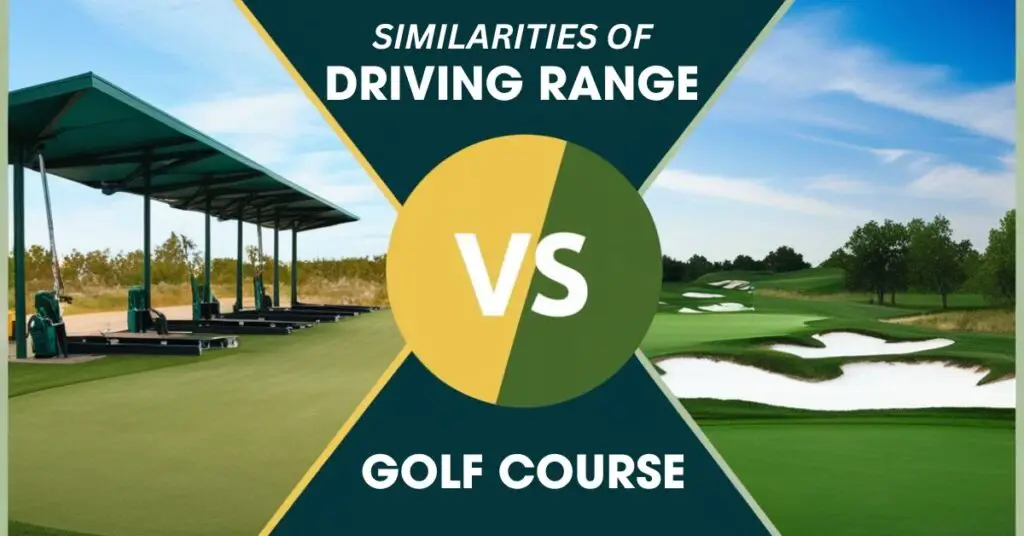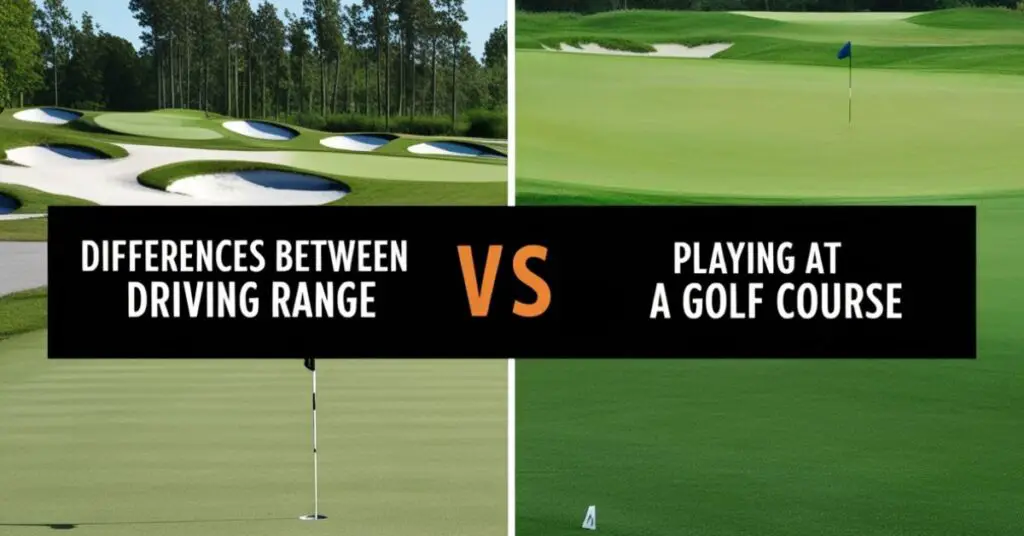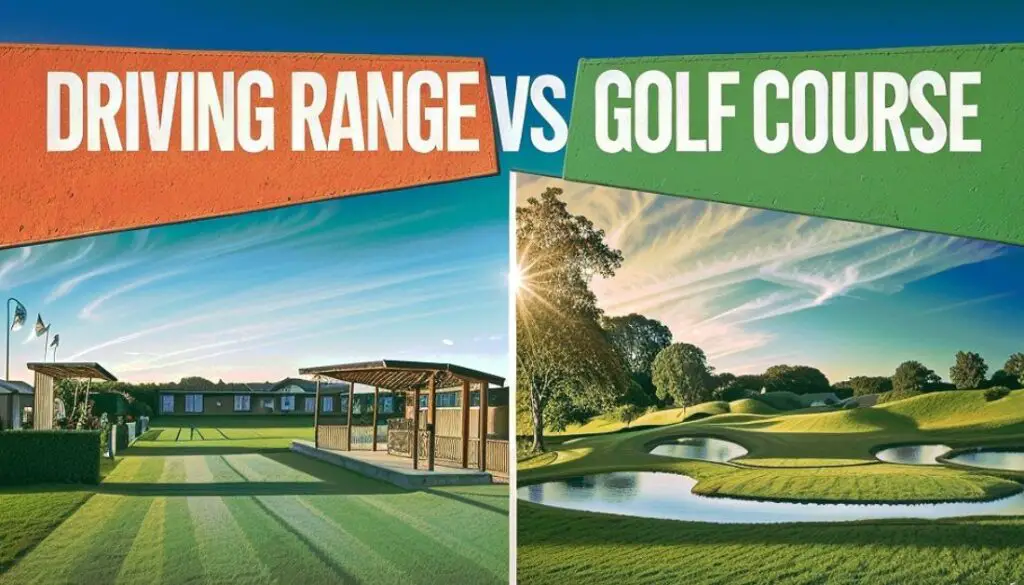If you’ve ever found yourself wondering whether spending more time at the driving range or hitting the golf course will truly improve your game. Both driving range vs golf course have their perks, but which one truly helps you get better? Maybe you’re tight on time, trying to save money, or just unsure where you’ll see the most progress. The truth is, that many golfers struggle with this decision.
According to a survey, 56% of golfers prefer the driving range for practice, while 44% believe that playing on the course is more beneficial, it’s clear that this is a common dilemma. In this guide, we’ll break down the similarities, differences, and pros and cons of the driving range vs golf course, so you can make the best choice for your game.
Table of Contents
ToggleSimilarities Of Driving Range vs Golf Course

When comparing the golf driving range and the golf course, it’s easy to focus on their differences, but they share some fundamental similarities that are crucial to your development as a golfer.
1. Focus On Golf Skills Development
Actually, the driving range and the golf courses are essential for improving your golfing skills. Whether at a driving range and practicing for fun or while on the field, playing an actual round, the goal is to increase the swing speed, and accuracy as well as the general performance of the game. The driving range allows you to hone such areas as driving distance or iron accuracy, whereas the golf course challenges you to apply those skills in real-game situations. Thus, regardless of the approach, the main requirement is the consistency and proper execution of exercises.
2. Use Of Golf Equipment
Regardless of where you’re playing, you’ll be using the same set of golf equipment. Your driver, irons, wedges, and putter will all come into play whether you’re at the range or out on the course. The golf game driving range allows you to practice with each club individually, getting a feel for different distances and shot types. On the golf course, you’ll use those same clubs, but in varied and sometimes unpredictable conditions. Both environments help you get familiar with your equipment and understand how to use it effectively.
3. Mental Preparation
Both the driving range and the golf course play a crucial role in mental preparation. In the driving range, you can work on your focus, concentration, and routine without the pressure of a scorecard. It’s a place where you can golf practice golf visualizing every shots and building confidence. In general, the match on the golf course is even more mentally dependent as you progress from one hole to the next, make decisions, and manage emotions. Tuning one’s mindset is an important part of progressing on the range or on the course, no matter the situation.
4. Social Interaction
Golf is considered a more social game, and this is true on the driving range as much as on the course. There are other things you may have to do on the range, such as meet and greet with your fellow golfers, advise one another, and even engage in friendly competitions. While playing a round of golf on a course, you are with your playing partners for almost 4-5 hours, and engaging in conversations is quite high in a round of golf. Both settings allow a person to meet individuals who share the same or similar interest in golf.
These similarities between the driving range and the golf course show that, while they serve different purposes, both are integral parts of a golfer’s journey to improvement.
Differences Between Driving Range vs Playing At A Golf Course

Understanding the differences between the driving range and the golf course can help you decide where to spend your time based on your current goals and needs. Both provide unique experiences that focus on different areas of your golf game.
1. Purpose
The driving range in golf course is mostly used for practice. It’s a controlled environment where you may concentrate on specific aspects of your game, including improving your swing or distance control. You can hit the ball better after ball without concern about the outcome, which encourages practice and muscle memory development. On the other hand, a golf course allows you to put that practice into action. The goal here is to finish the course with the fewest strokes possible, which requires strategic thinking, course management, and flexibility in changing situations.
2. Layout
Driving ranges golf course are typically flat, open locations with well designated distances where you can aim at a variety of targets. You’re striking balls into a wide field, with markings to indicate distance. This simplicity enables you to concentrate on your technique without distractions. A golf course, on the other hand, is a sophisticated layout comprising 18 holes, each of which presents a distinct difficulty. You’ll confront a variety of terrains, perils such as bunkers and water, and height changes. The course layout’s versatility tests your ability to adjust your game to changing conditions and settings.
3. Rules
At the driving range, the rules are simple and flexible. There’s no need to worry about penalties, out-of-bounds, or pace of play. You can take your time, experiment with different techniques, and hit as many golf balls as you like. In contrast, playing on a golf course involves adhering to the official rules of golf. You’ll need to manage your strokes, avoid penalties, and maintain a steady pace to keep the game flowing, especially when playing with others.
Also Explore: The Golden Basic Rules Of Golf For Play Like A Pro
4. Turf And Practice Conditions
The turf at a driving range is often artificial or heavily worn from repeated use. While some high-end ranges might offer natural grass, the conditions are usually not as varied or realistic as those on a golf course. You can still practice your swing mechanics, but it may not seem as natural as it would on a real course. You’ll face a variety of lies on a course, including fast or slow greens, heavy rough, and narrow fairways, each requiring a unique strategy and skill set. This diversity is key to developing a well-rounded game.
5. Cost
Another difference that can be pointed out is that of cost. A range session with almost the balls is relatively inexpensive in comparison to the round of golf. You can practice as much as you want, and it is cheap to hit shots as many times as you wish for a relatively low fee. This makes the golf driving range game a relatively cheaper option when it comes to practice as compared to the course.
However, the complete playing of golf on a course requires a green fee, which is usually very costly and depends on the course’s quality and location of the course. Also, some charges may accompany, for instance, cart fees and caddie services. However, playing on a golf course is way more costly, but it gives you a complete experience of a game that can hardly be replicated when practicing on the driving range.
Based on all this information, you will be in a position to choose between the appropriate environment depending on your present proficiency and the kind of golfing that you want to achieve.
Pros And Cons Of Driving Range vs Golf Course

When selecting whether to practice at the driving range or the golf course, look at the pros as well as cons of each. Both environments provide unique benefits and challenges that can influence your overall game improvement.
Pros Of Driving Range
- Focused Practice: It provides the opportunity to work on certain parts of the golf game without the distractions of a full round. You can work on your swing, experiment with different clubs, and practice repeatedly until you feel confident.
- Cost-Effective: Using the golf ranges is relatively cheaper than having to go through a standard round of golf. You just have to pay a relatively small amount of money to be able to hit hundreds of balls and practice until you want to.
- Convenience: Driving ranges are often much simpler and take less time than a full round of golf. A quick practice session during your lunch break or after work will help you maintain a regular practice schedule.
- Less Pressure: Unlike organizing the game where one has to look at the scoreboard or mind the rules of the course, the driving range, therefore, the driving range offers a low-pressure environment where you can focus solely on improving your technique. It is extremely useful to practice in such conditions for beginners or while working on certain abilities.
Cons Of Driving Range
- Limited Realism: The driving range provides a controlled environment that doesn’t fully replicate the challenges of a golf course. Factors like varying terrains, hazards, and changing weather conditions are missing, which can make it harder to transfer your practice to actual play.
- Repetitive Practice: As it is clear, it is recommended to repeat movements to improve muscle memory although it also has the downside of making the exercise boring. Practicing by hitting balls all day might not give you challenge your decision-making skills or adaptability which are very important while playing the course.
- Artificial Conditions: The turf and mats at driving ranges often differ significantly from the natural grass on a golf course. This can affect how your golf shots on the range feel and behave, potentially leading to unrealistic expectations when you transition to the course.
Pros Of Golf Course
- Real-World Application: Playing golf on a course puts your skills to the test in realistic situations. You will encounter a variety of terrains, hazards and weather situations, all of which need strategic thinking and flexibility.
- Comprehensive Skill Development: A game of golf tests you on nearly all parameters of your golfing skills, namely, driving, use of the irons, chipping and putting. Takes you through the entire process, showing where you were good, and where you need to be better.
- Mental Toughness: The golf course environment is more demanding mentally. You’ll need to manage pressure, make strategic decisions, and stay focused throughout a round. This mental challenge is crucial for improving your overall game.
- Enjoyment and Social Interaction: Even though the overall point of going through a round is to perfect a golfing technique, it is also relevant to have fun and social interaction in the process. Regardless of this, the overall experience of having been on the course if you intend to play competitive golf is more satisfying.
Cons Of Golf Course
- Higher Cost: When it comes to the cost, it is usually cheaper to practice at the driving range rather than play at the golf course. When one needs to practice frequently, it may get somewhat costly because green fees, cart rentals, and other expenses can add up.
- Time Commitment: Golf is an extensive activity that may take several hours to complete; As a result, those with busy lifestyles find it difficult to participate. This may be a disadvantage in brief and on-the-spot practice sessions.
- Greater Pressure: However, golfers are under a lot of pressure because decision-making and scoring occur in a more formal environment on the golf course. This can be challenging for beginners or those who prefer a more relaxed practice setting.
- Physical Demand: The full tour of an 18-holes course let alone having the course having hills and other forms of terrains can at times be tiresome. This can be a disadvantage, especially in a situation where people want to have a relaxed practice session or have some physical complications.
Balancing the pros and cons of both the driving range and the golf course is critical to building a complete game. Each location has a place in your training schedule, based on the component of your golf game you want to improve.
Also Explore: How To Build A DIY Golf Net – Easy Guide For Golfers
Which Is Best for You: Driving Range or Golf Course?

Choosing between the driving range and the golf course is determined by your goals, experience level, and what you hope to achieve from your practice or playtime.
For beginners, or focusing on some element of your golfing style, swinging the driving range might be the most effective place to start. As an addition, it gives the player a kind of safety zone where he can practice or master the basics without having to worry about the full game. This is a positive side because you are not under pressure from other players in a range, so you can take as many shots as you want to build confidence and consistency. It is also less expensive and takes less time than other kinds of practice, allowing candidates to practice more frequently.
On the other hand, if you want to develop a solid foundation and want to test your skills in a real-world setting, then the playing field which is the golf course is where you’ll experience the true challenge of the game. A full round represents the various activities and situations that might happen in true social round competitions. It pushes out the best in one’s technique and evaluates the planning skills, patience, strategic thinking, and competitive spirit that each student possesses. While it requires more time and can be more expensive, the experience is invaluable for those looking to elevate their game.
Finally, it has come down to one shading choice depending on your goal. In a way, specific to the golf, the driving range is an ideal location, where your priority is focused, repetitive practice, and building muscle memory. But if you want to apply what you’ve learned to more challenging activities, then the golf course provides that comprehensive learning experience you require. Many golfers find that a combination of both is the most effective approach, using the range for practice and the course to put those skills into action. If you are able to split time between the two, you will be able to come up with a balanced game that has all the options well prepared just in case.
Conclusion
In the end, whether you choose the driving range vs golf course depends on what you want to get out of your practice. The driving range is great for focused practice on the course, especially if you’re working on specific parts of your game or just need a quick, cost-effective way to improve. On the other hand, the golf course offers a complete, real-world test of your skills, pushing you to think strategically and adapt to different challenges.
Finding a balance between the driving range vs golf course might be the best way to keep growing as a golfer. Practice at the range to sharpen your technique, and then take those skills to the course to see how they hold up in real play. Both are important and together, they’ll help you become a better golfer.



